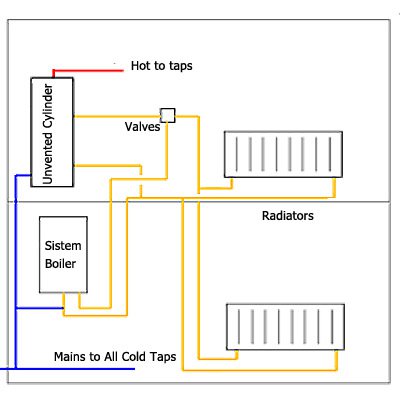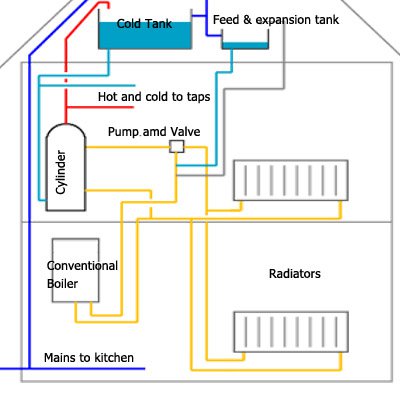Combi Boiler
Combi boilers are very popular in this country. Also known as Combination or combi boilers, they boast a high level of efficiency and consume moderate amounts of energy. They heat up water only when the owner needs hot water. This appears to be the best option for small to medium-size apartments and/or houses with relatively small numbers of residents. These appliances do not feature separate hot water tanks. They heat water that comes in from the mains water supply when necessary. Thus you can provide a constant supply of hot water without fearing a cutoff. You get a kind of combination of central heating and an autonomous water heating unit, which complement each other and together work like clock.

Because the system does not require installation of an expansion tank, feed tank or cold/hot water storage tank, it appears to be very space-efficient. It distributes water from the mains around your home relying on the existing pressure. Therefore, it should be noted that the pressure will fall if you use several outlets simultaneously. Given the system’s compact size and general effectiveness, it can be an excellent substitute for a traditional boiler.
You can see what a regular combi boiler system looks like in the picture on the right. The most important thing about this kind of boiler is that it requires a sufficient mains flow rate. Please, check it before installation.
Combi boilers are very popular in the UK and elsewhere, as they provide a stable supply of hot water and can keep a house warm without having to use extra tanks or cylinders. There are electric and gas combination appliances.
Pros:
It provides as much heat and hot water as you need;
You do not need to install several tanks;
Combi systems are compact and therefore space-efficient.
Cons:
If you have to use several taps at the same time, the water pressure may drop;
Installing a combi boiler requires professional assistance.
Where is it best used:
Combi boilers are well suited for all types of homes. However, it may not be a perfect choice for a family where several people use hot water simultaneously.
System Boiler
System boilers (sealed systems) feature cylinders, which are usually placed inside airing cupboards. They do not use water tanks.

The presence of a hot water tank (cylinder) makes system boilers similar to conventional systems. Meanwhile, a system boiler comes with a pump and an expansion vessel, which are part of the heating system integrated into it. For this reason, installing such a system is less tricky and time-taking. Systems with unvented cylinders do not require the use of a cold water tank. Therefore, they take up less space and can be converted later, if necessary. System devices are great for families who use hot water frequently and in large amounts.
Pros:
They do not take up much space in the attic;
Many taps can be used at the same time.
Cons:
They take a bit of time to heat up water;
Every time hot water runs out you have to wait until it heats up again;
You have to look for a place to install a cylinder.
Where it is best used:
In homes where hot water is used by many people simultaneously.
Conventional (regular) Boiler
Conventional boilers include a whole bunch of components: a cold and hot water cylinders, cold water storage tank, and expansion tank, which fills the central heating system with water. Because they are capable of storing large amount of hot water (with a number of outlets being used at the same time), they are suitable for homes where hot water is used intensely. They can be paired with domestic cold and hot water pumps, which distribute water around the house.

These boilers are compatible with old low-pressure radiator systems, which are not suited for combined boilers, because they require high pressure in the system. Any time you need higher pressure in your domestic system, you can use you can use a pump. Regular boilers also pair well with solar heating panels.
Pros:
You can open many hot water taps at once without having to worry about pressure drops
Cons:
It takes a bit of time to reheat water after you run low on hot water;
The tank and cylinder take a bit of space and should be installed by a professional.
Where it is best used:
Residences where several people have to use hot water simultaneously.